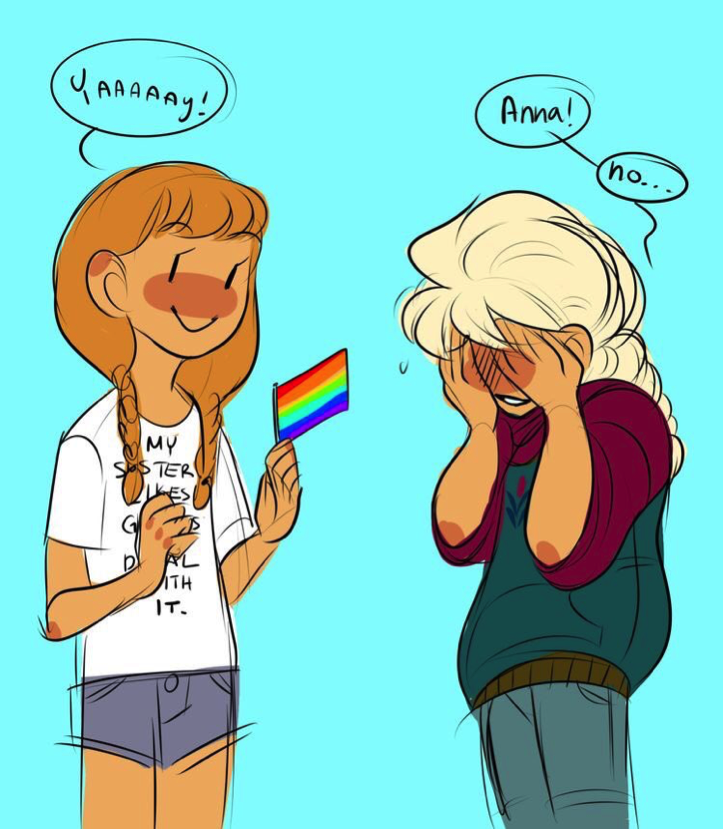In fan studies, we often talk about fans being ‘poachers’ of texts (Jenkins 1992). Fans, we argue, lift bits and pieces from texts and create their own works: Sherlock becomes a detective in a high school; Edward and Bella become billionaire and college student; Harry falls in love with Snape. Queer relationships are commonplace in fans’ rewritings of texts and scholars theorize the subversive potential of reading homosexual relationships into a conically straight (or canonically ambiguous) text. Yet, there shouldn’t have to be anything subversive about queer relationships.
In an article for MTV News, Alexis Isabel Moncada writes:
The entertainment industry has given us girls who have fallen in love with beasts, ogres who fall for humans, and even grown women who love bees. But we’ve never been able to see the purity in a queer relationship (Moncada 2016).
Characters who can be read as queer have often been depicted as the villains of the piece (think at Scar, Ursula or Jafar)[1]. This representation, as well as comments like those from Disney Channel network president Gary Marsh (2013) that it’s “for the audience to interpret” who is and isn’t gay, lead queer fans to search for hints – however small – that some characters may be queer. When Finding Dory was released in 2016 the internet was rife with speculation that it showed Disney’s first lesbian couple, and when Frozen was released in 2013 many viewers read the film as featuring a gay relationship[2].
More than simply (subversively) reading some relationships as queer, though, fans have made their own attempts to garner more screen-time for LGBT characters in animated films (see Galuppo 2016). In particular, May 2016 saw a Twitter campaign for Frozen’s Elsa to become Disney’s first lesbian princess, with the hashtag #GiveElsaAGirlfriend trending on the site. The hashtag was created by Alexis Isabel Moncada after she realized that, while Frozen is seen by many in the LGBT community as a metaphor for coming out, Elsa would probably end up in a heterosexual relationship in the sequel. She tweeted how iconic it would be if Disney made Elsa a lesbian and gave her a princess to rule alongside, rather than a prince.
The hashtag soon began circulating on Twitter and became a trending topic. It also featured on Twitter’s ‘moments’. With Frozen being the ninth highest grossing film of all time, garnering a global box office of $1.27 billion, a lesbian princess would go at least some way to placing queer relationships on par with straight ones. And it is for this reason that fans have become not only remixers, but also activists. Cartoons are, for many children, the first introduction to the media they have, and are places where they look for themselves.
As The Daily Beast’s Kevin Fallon writes regarding the #GiveElsaAGirlfriend campaign,
When you grow up gay, or wondering if you might be gay, you search for yourself in any way you can in these tenets of pop culture that become integral parts of your childhood, which are highly influential in the person you become and the attitudes you have about certain morals. It’s not just gay people who do this. We all do; it’s just harder for some of us to see ourselves (Fallon 2016).
While it is important for fans to poach from these texts and create the characters and relationships they wish to see, it is just as important for those relationships to feature in the cartoons that the industry produces.
References
Fallon, Kevin. 2016. “#GiveElsaAGirlfriend and Disney’s Super Gay, Super Troublesome History”, The Daily Beast, http://www.thedailybeast.com/articles/2016/05/05/giveelsaagirlfriend-and-disney-s-super-gay-super-troublesome-history.html
Galuppo, Mia. 2016.”#GiveElsaAGirlfriend to Finding Dory: The Online Push for LGBT Characters in Animated Movies”, The Hollywood Reporter, http://www.hollywoodreporter.com/news/finding-dory-frozen-lgbt-characters-898354)
Jenkins, Henry. 1992. Textual Poachers: Television Fans and Participatory Culture. London: Routledge.
Marsh, Gary. 2013. “Why Are There No Gay Disney Characters?”, Saloon, http://www.salon.com/2013/06/01/why_are_there_no_gay_disney_characters_partner/
Moncada, Alexis Isabel. 2016. “Why I Created the Trending #GiveElsaAGirlfriend Hashtag”, MTV News, http://www.mtv.com/news/2875696/why-i-created-the-trending-giveelsaagirlfriend-hashtag/?utm=share_twitter.
Bethan Jones is a NECAH funded PhD candidate at the University of Huddersfield. Her thesis examines cult television, fandom, nostalgia, and the X-Files and Twin Peaks revivals. Bethan has published extensively on fandom, gender and new media. Among others, her work has appeared in the journals Sexualities, Transformative Works and Cultures, and New Media & Society, as well as in edited collections for Bloomsbury, Routledge and Palgrave. She has also co-edited the collection Crowdfunding the Future: Media Industries, Ethics, and Digital Society (Peter Lang 2015). Bethan is a board member of the Fan Studies Network and a principal researcher in the World Star Wars Project.
[1] See http://www.dailydot.com/via/ursula-little-mermaid-disney-movies-lesbian.
[2] See respectively http://www.pinknews.co.uk/2016/05/25/finding-dory-trailer-appears-to-feature-lesbian-parents/ and https://mic.com/articles/79455/7-moments-that-made-frozen-the-most-progressive-disney-movie-ever#.YDfy4PKL4.





1 comment for “#GiveElsaAGirlfriend and the Importance of Mainstream Queer Cartoons”